Menus
- Sporty motorbike or three-wheeler
- Discovery
- In the saddle
- Contact
- In the city
- On the highway
- On departmental
- Braking
- Comfort
- Convenient
- Consumption
- Conclusion
Sporty motorbike or three-wheeler
A bomber…. in every sense of the term. Because the Can-Am Spyder is a pure recreational product signed by BRP, for Bombardier Recreational Products and even more in its latest 2015 version called F3. We are indeed not far from a variation of F1 on three-wheelers with a Rotax engine that delivers no less than 115 horsepower ! Yes, the one hundred horsepower bridle does not have to be on this product, 100% full and 100% fun, including for motorists since a motorcycle license is not required to drive it. So after the RS, RT and ST models, Can-Am offers a more roadster and less road version. We criticized a little intrusive electronics on the old models. What about this new version which imposes an almost custom-style position with the feet more forward but still with such a futuristic and above all sporty line with this model compared to the RT plus touring model?.
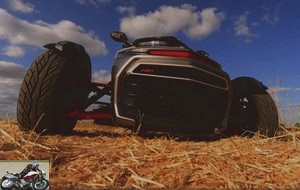
Discovery
A three-wheeler already has little to do with a motorcycle. There are certainly scooters and BRP was not the last to create them, notably with jet skis (See-Doo) and snow scooters (Ski-Doo). But here it has nothing to do with a scooter and even less with a trike. The Can-Am is like no other with its two front wheels and huge rear axle. The tires themselves are similar to those of cars. Only the central saddle with the footrests approaches the motorcycle position without forgetting the handlebars with flat handlebars. The front here is massive, bodybuilt, athletic, close to a big feline ready to pounce. The orange trellis frame emphasizes the sporty appearance and the Rotax 1330cc engine. The sharp look with a double front optic as wide as it is narrow in height commands respect. The front mouth seems ready to swallow the kilometers.
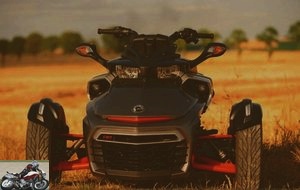
The F3 is also available with an F3-S version, even sportier, with cruise control, painted and machined rims, a suede saddle with red stitching, not to mention a front fender with integrated LED light..
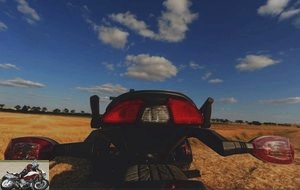
The rear light retains the sporty appearance by being particularly tapered. The rear tire is protected, limiting the rise of water in the event of rain on the passenger.
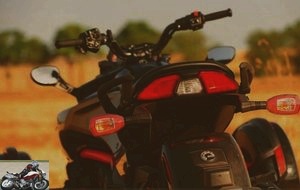
In the saddle
We step over the wide saddle. The outside impression is mellow. Once seated, the impression is confirmed by a particularly comfortable seat. The feet move forward slightly to rest on the footrests, with a sensitive custom position. The arms literally rest on the wide handlebars as the elbows come down naturally. On a motorcycle you don’t think about changing this position.
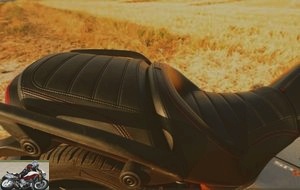
With the F3, this is possible with the Ufit system which allows you to choose a position to your liking, depending on your size and riding style with 4 sizes of handlebars and 11 positions for the footrests. Only a dealer can make these changes but they would take less than a quarter of an hour (provided you have different handlebars and return rods).
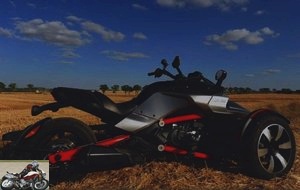
We have in front of us a cockpit worthy of the best sports with a tachometer graduated up to 200 km / h on the left and a tachometer climbing to 10,000 rpm on the right, with no red zone displayed. Then there is a huge digital counter in the center with all the necessary information: fuel gauge, engine temperature, clock, partial double trip, totalizer, speed, gear engaged ….
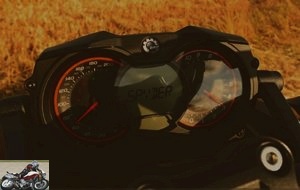
We had a semi-automatic gearbox with the F3-S and therefore no clutch handle.
On the left, we find the parking brake, not to be forgotten before switching off the ignition. Anyway, in case of forgetting, the alarm makes you switch on the ignition again to press the big button (P).
Contact
Foot on the right brake pedal (there is no brake lever) and finger on the starter button, the big 1300 cm3 snorts with a hoarse and serious noise (after a long stop, do not forget either plus the initial press of the mode button). We tickle the right handle and the beast seems to want to pounce more than ever. Gear engaged with the paddle on the left, the first engages. And the feline sprang up, on the finger of the right hilt. Slowly if you dose, violently if you open wide until the tires screech on the road. Tell your front passenger, so that he or she holds on well and strongly, especially if you want to check 0 to 100 km / h in 4 "8! You read that right! Since you are told that it is pushing !
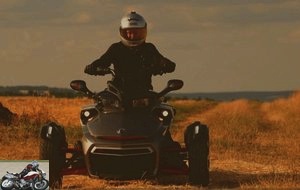
In the city
The first turns of the wheels are instinctive. The front end is as wide as the rear is thin. And if the front wheels pass, the rear will necessarily pass. It’s almost natural for the rider. On the other hand, no counter-steering to turn. The Can-Am is more like a quad when it comes to handling than a motorcycle itself. When braking for the first time, we look for the brake levers, but light pressure on the brake pedal brakes hard. And if we run over it, we have to hold on so as not to end up in front.
The Spyder accepts almost any revs, accepting a gear shift every 10 km / h. We can thus drive on the torque in town at 50 km / h on the fifth report just like staying in the first report without making the engine roar. With the sequential gearbox, the gears descend automatically according to the speed. On the other hand, they must be mounted on the pallet. And in case of lack of habit, a small arrow is displayed to the left of the gear engaged on the dashboard to signal to shift a gear. It all depends on the pace that you want to impose or impose … because the F3 really accepts just as well to wind on the couple as to start with a bang with a real kick in the butt extra when the 5,000 passes. rpm. In all cases, the gearbox is an example of approval without any unpleasant jolts, neither in going up, nor in automatically lowering the reports. We would almost forget it !
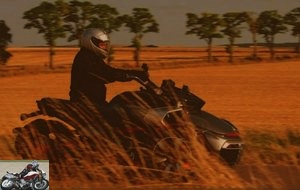
You fit in naturally with traffic, with a seat height that allows you to see over the cars. The front wheels are the width of a car. So, forget about the interfile. Only point, the acceleration is hellish and we manage to squeeze quickly through a mouse hole to zigzag in a way impossible to do in a car. It doesn’t really go easily between the lines, but it can move and come out more easily. Suddenly, if you live in Paris, you will hardly see any advantage there in terms of ease of movement compared to a car, except the added fun..
And to park, what do you do with a monster weighing more than 400 kilos with the full tank? We can go down and push him. It is doable, we have tested. But there is mostly a reverse gear and with a little practice, we park really easily, while avoiding the sidewalks.

On the highway
With a straight grip, the Can-Am literally leaps on the highway. At a legal speed of 130 km / h, it is at 4,000 rpm and then at 150 km / h, the tachometer only indicates 5,000 rpm, or half the maximum speed in the last gear. And you just have to turn for it to go up 20 km / h every 1,000 rpm. But it is your necks that will cry for mercy before the engine. Because at 150 km / h, it already pulls as hard as if you were driving a roadster and at 170 km / h you start to want to release the handle. What is fantastic then is the overall feeling of speed. In town, the slightest acceleration gives the impression of speed much higher than that of a motorcycle at equal speed. This is still the case on the motorway where the landscape seems to go by at full speed. For the anecdote, it must be said that at 150 km / h the difference between the real speed (GPS measurement) and the counter is only 5 km / h when it can already be 10 to 15 km / h on a motorcycle. In the meantime, the Can-Am is imperturbable in a straight line and just as much in a big curve. You have to hold the handlebars noticeably more, but not excessively and it is still possible to let go of the handlebars with one hand to greet a crossed biker. However, the handlebars react very sharply to requests to change direction and we sometimes find ourselves changing lanes almost too quickly. And once you stop playing at prohibited speeds, you can still engage the "eco" mode and especially the cruise control to stall at 130 km / h with a flick on the right switch. All you have to do is push the button up to increase the speed or down to decrease it. So easy and instinctive, that in the end, we end up cruising at 130 permanently on the highway.
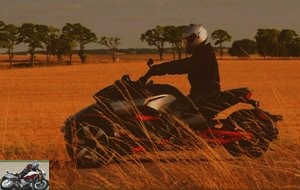
And if the traffic jams happen, we can almost do some interlinking. I say almost because cars see the helmet coming and shift naturally back and forth across the road, even allowing the Spyder’s impressive width to pass between the lines..
Last major point, the Spyder seems almost indifferent to the condition of the road. It is able to pass like a flying carpet over large holes in the road, even well launched, without generating hazardous behavior. He just stays glued to the ground. Admittedly, it can shake in the case of really deep holes, but everything remains perfectly stable and in line with an additional feeling of security which makes you open the handle even wider..
On departmental
We often go down the departmental road to start having fun, especially since the Spyder is responsive, dynamic and manoeuvrable. As long as the pace remains quiet, at 100 km / h and only 3,000 rpm, driving is natural. But when the pace starts to pick up, you grab your heart and you arch your handlebars. It’s fun and just as physical despite the power steering. Because the F3 turns flat. So you have to push and resist the rapid changes of direction to make it go where you want and especially resist the centrifugal force which tends to want to eject the pilot from his mount. And that contributes to the pleasure of feeling like you have to play and tame an animal. On a motorcycle, you just have to bow and the bike goes where the eye goes. With the Can-Am, you just ride a rodeo bull and the pleasure also comes from driving a little sporty and more and more sporty as the speed increases..
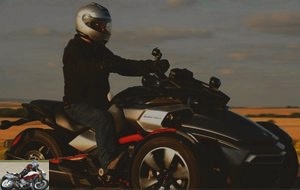
Fortunately, like its predecessors, the F3 comes with TCS traction control, Bosch three-channel ABS and a non-switchable stability control system. Particularly intrusive on older models by cutting easily, which can lead to frustration when driving, the limits of the F3 are much further and even when driving very fast, we were unable to trigger it. You really have to kick the handlebars hard to turn while putting the throttle back on to get them going and again, in a more safe rather than intrusive way. In short, a rally driver will be able to trigger the assistance, but not a standard driver who will not feel the intervention and will no doubt be very happy to feel it if it engages. The only downside is more about the passenger. Because if the pilot plays in front and knows when and how he will turn and compensates by anticipating the maneuver, with a sporting rhythm, the passenger can find himself tossed to the left and to the right, while clinging desperately either to the handles or to the pilot. to stay on the frame. The book reading mode while driving is therefore to be avoided on departmental roads. But again, it all depends on the driver. In coiled driving, everything is fine. And in sporty driving, it is quite easy to make your passenger seasick..
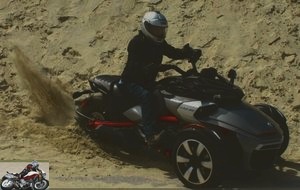
And if you go into the mountains, to chain the virolos, the first vigors and gnac down to go on the attack will make you reduce the pace after a few tens of kilometers, not because the F3 is scary, but because if you are not a minimum athletic, you will no longer have arms! And that said, the F3 allows very little improvisation and a turn that closes particularly with excessive speed can make you pass the center line more easily than on a motorcycle, where you can sometimes lean a little more, tilt and pass, when here, the F3 will be a little more reluctant to joke.
Braking
First of all, you have to get used to the lack of a brake lever. There is only one foot brake. Except, on a motorcycle, foot braking rarely offers the feeling provided by the handle. Nothing like that here. Despite a custom-style position, the feedback in the foot is important. The feeling is good and above all the power is really there and in a progressive way. We can therefore touch the pedal or on the contrary crush it but with a wide range of precision between the two. The braking coupled with the Brembo calipers is then impressively efficient, which does not manage to trigger the ABS, in the dry at least..
Comfort
The saddle appears soft to the eye, then to the seat. But it’s still better than that after 250 kilometers where you could still drive a long time without suffering from the rear end. The excellent suspension work combined with a seat that is as soft for the rider as the passenger really makes it possible to envisage long rides. In fact, only consumption forces you to stop after 250 kilometers.
Convenient
The switch opens the boot…. front which corresponds to a small top-case, allowing to accommodate a full face helmet and a large rain suit. If you want to take more stuff, you have to switch to the RT model with its 150 liters but forget the F3 or be satisfied with the 2 optional side cases of 50 liters each.
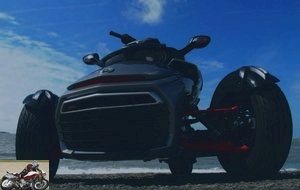
Consumption
Sporty, dynamic, the F3 also weighs over 400 kilos that you have to take along, not to mention limited aerodynamics even if the line is magnificent. Suddenly, when we go to the reserve at 250 km, we put between 20 and 22 liters in the tank (which contains 27), an average consumption varying between 8 and 9 liters per hundred. At legal stabilized speed on the motorway in eco mode, we consume 8.05 liters. With a really eco driving at 90 km / h, we must manage to go below 8 liters, but with a more sporty driving we can exceed 10 liters per hundred. The range of the Can-Am can therefore vary from a minimum of 300 kilometers to nearly 350 km. The monster is greedy.
The tank, placed in the center like on a motorcycle, is just as easy to fill, in particular thanks to a cap mounted on a hinge.
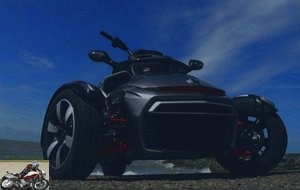
Conclusion
Dynamic, playful, efficient, the F3 is a really extra toy…. for the provincials. Its use in the city is limited, not to mention that with its ardor and the speed it can reach in a few meters, it is a radar weapon with the risk of detonating them easily, too easily. This is truly a pure recreational product, for those who want to have fun and experience, while riding a mount that values their rider. Everything becomes a game on its handlebars and we want more and more, until we are thirsty. Only the 21,499 euros of the F3-S version, or even the 18,999 of its standard version with the F3 can make you think. There is then still the possibility of turning to the RS model at 14,799 euros even if it does not benefit from the same expressive engine (a 998 cm3 instead of the 1330 cm3). In the meantime, if you want to have your picture taken as soon as you step outside or see passers-by turning around in your path, whatever you choose, this is the effect the Spyder has on its surroundings..
Strong points
- Look
- Motor
- Driving sensations
- Comfort
- Braking
Weak points
- Consumption
- Practical aspects
- Non-disconnectable assistance
The BRP Can-Am Spyder F3 S technical sheet
Related articles
-
The Touring sporty version … or the other way around… After the RT and especially the Spyder F3-S, Can-Am returns with a new three-wheel model placed…
-
BRP Can-Am Spyder RS and RT Test
Horse of three ! The Can-Am Spyder, an astonishing automobile front-end trike, is celebrating its 5th anniversary this year. The opportunity for us to…
-
The three-wheeler accessible in its 600 and 900 Rotax versions Should we still present the or rather the Can-Am, especially in France, which represents…
-
Japanese Spice Choper. When Honda introduced the Fury in 2009, no one believed it … what could have prompted a Japanese brand to create such an extreme…
-
1100 km test. Unveiled at the Tokyo Motor Show in 2005 but presented only in 2008, the DN-01 is a rolling concept, at automatic or sequential speed,…
-
The grasshopper 10 day trial We have been waiting for several years for a basic to replace the ER-5. In the renewal of its range and in particular…
-
Ducati Hypermotard 796 motorcycle test
The Ducati 796 twin-cylinder in 2010 vintage supermot version. The Ducati Hypermotard 796 is the variation of the Hypermotard 1100, presented at the…
-
Honda SH 300 maxi-scooter test
The HS is another The SH 300 is the Honda scooter with a flat bottom and large wheels, here in a 300 cm3 version … Svelte and urban are the hallmarks…
-
Biker test: R-One All the world dreams of one day finding THE motorcycle. The one who changes life in the absence of the world, which retraces the roads,…
-
Piaggio MP3 500 LT ie scooter test
MP3 … Piaggio never stops offering its flagship three-wheeler in all possible displacements and variations, business included. In the LT version (Large…
hello..a quick note to say that I enjoyed reading this post..
it turns out that you made a small mistake but I would not want to swear it .. it is about the relative power to the free version. you indicate that this one is 180chx .. after reading several data sheets it appears that the power is 192chx including 7 for the forced air system at high speed under the double optics..
I am 52 years old and I happen to have a 12 free version from 2001..I would like to talk to you about the wear of the rear tire .. in some forums devoted to the 12 there are some who say that you should not hope to do more than 3 to 4000kms, 5000 big maximum .. I claim the opposite .. I have mine since April 2008.
at the time of purchase from a private individual it was 5140kms exactly and according to the owner it had 200 terminals in the range … I readily believed it saw the depth of the sculptures..
I really don’t ride a lot … almost 5 years later, my 12 (which I love ..) is only 14800kms.
the tire which is finally worn has therefore held up to now … I remind you that it has been there for about 4910kms.
he will have held at least 9890kms … when I talk about it with friends, they tell me it’s impossible, almost treating me as a liar..
I am not a fan of burns and besides I never do .. when I see some smart kids drowning in a plume of smoke it hurts my heart. Here we are destroying 2000kms of autonomy in 3 minutes. .brief..I always start normally..when I drive, I favor flexibility over engine torque and finally, I check the pressure at least once a month.
and it’s not exaggerated because I lose between 50 and 100g between each time.
do you find the same longevity on yours?..
otherwise I confirm pretty much everything in your post..I’m precisely 1.75m and it’s true that I barely have my feet flat on the ground … the couple is demonic too..mine is a version free..
when I put gas on high around 140-150 it goes so well that I always have the impression
even 5 years later to have forgotten to pass the sixth but no because the last gear is well locked … do you find the same feeling??..
and finally as you talk about braking I am 100% ok with you … since always I found that there was hardly any brake at the rear or so little and again by pressing hard enough.
a kind of retarder as you say … in fact, I use it when entering a tight turn to seat the bike. the rest of the time I let it fall. the front brake is almost sufficient on its own..
but still..in 80 when I took the same roads with my z500 it braked much better at the rear..de facto I wonder why the rear brake is so weak on a 12..
here again thank you for this beautiful article worthy of a professional..
best regards and may the holy mess tin protect us..eric а sète ..
ps:. I wanted to put 5 stars so much I found myself there with my 12 but I know what I hacked because there are only 2 … sorry, really … eric ..
Hello
About the fuel consumption I arrived with myZX12R from 2001 to 10lt 100
After you 9 lt
It turns out that by driving eco in the countryside without regular highways I arrive at 7.5 lt
Conclusion drive eco … or not
In any case motorcycle bought in 2018 for 1800.-fr Switzerland that happiness … thank you to you
Am available if questions
Emmanuel, you write like a chef.
that’s prose.
I had a 1000 RSV from 2000 and I did 64,000 kms with it without giving it a gift because I used it as if it were a Japanese woman and I only had a problem with freewheeling. starter guaranteed. Out of my 3 bikes I’ve had so far this is the one I’ve had the most fun with. I loved it, for its handling, braking, character and engine performance. I got out of the way once with an R1 and it was only when I picked up that it nibbled on me a little time but I came back on it in the curves and top speed side it was kif kif except on the level counters because the Aprilia one is very accurate and the R1 one cheats quite a bit. While his odometer was 295km / h mine was 265km / h and yet I was behind and it’s not a question of aspiration because when I was in front it was the same.
In short, it’s a great bike.
Reply to this message